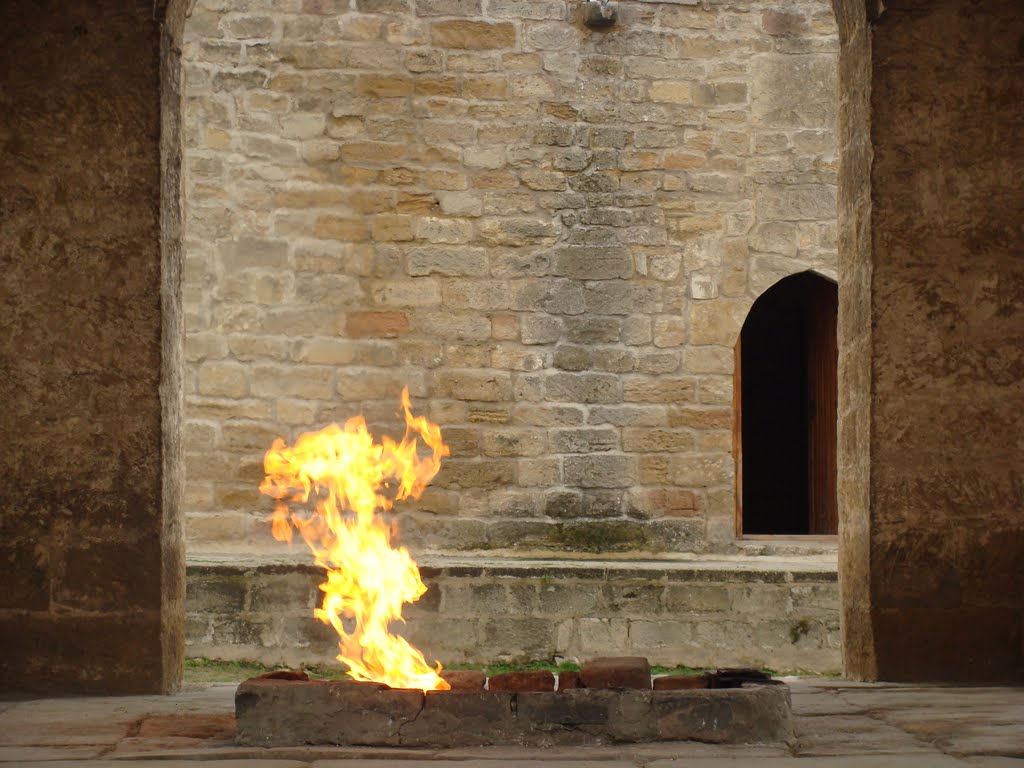The article below “Zoroastrians of Apsheron: from Sassanians to present days” is written by Farroukh Jorat from the Republic of Azerbaijan (formerly known as Arran and the Khanates until May 1918).
===================================================================
Baku is the capital of the Azerbaijan Republic, which called by poets as “Land of flames”. This country was the part of Great Iran from ancient times until XIX century. In this article I will briefly talk about Zoroastrian history of Baku and Apsheron peninsula.
Before Sassanians
The earliest mention of Persians in the Caucasus is found in the Greek historian Herodotus’ account of the Achaemenid expansion of 558-330 BC, during which they annexed Transcaucasia (South Caucasus) as the X, XI, XVIII and XIX satrapies of their empire
Archaeological material uncovered in present-day Azerbaijan, Armenia and Georgia include Achaemenid architecture, jewelry and ceramics [2].
Beginning of Sassanian times
Earliest mentions of a Zoroastrianism in Transcaucasia dates back to the Sassanians, who founded here the fire temples. Mobed Kartir (III c.) write in “Kabah of Zartusht”:
“And from earliest times onward for the sake of the Yazads and noble lords and for my own soul’s sake, I, Kartir, saw much trouble and toil. And I made prosperous many fires and magi in the empire of Iran. And I also, by command of the King of Kings, put in order those magi and fires which were for the territory outside Iran, wherever the horses and men of the King of Kings arrived the city of Antioch and the country of Syria and what is beyond Syria, the city of Tarsus and the country of Cilicia and what is beyond Cilicia, the city of Caesarea and from the country of Cappadocia to Galatia, and the country of Armenian and Georgia, and Albania, and from Balaskan to the Alans’ pass. And Shahpuhr, King of Kings, with his own horses and men visited with pillaging, firing, and havoc. But I did not allow damage and pillaging, and whatsoever pillaging had been made by any person, those things I had taken away and returned to their own country” [3].
Movses Khorenatsi in V century in the description of Bhagavan on the Caspian coast mentioned about Sanctuary with seven worshiped holes and referred to the establishment of the Shah Ardashir I (227-241) fire temples in Bhagavan [4]. Bhagavan (Bagavan) is one of medieval names of Baku. Ghevond Alishan described them as seven holes with burning oil which were called “Azer Pehram” [5].
Obviously, we are talking about a fire temple “Ateshgah” in the village of Surakhani (near Baku) where burned seven eternal flames.
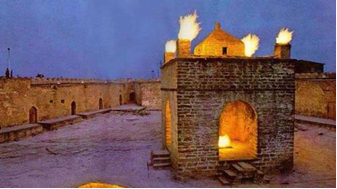
Fire temple Ateshgah (Source: Farroukh Jorat).
Also there is another tower fire-temple called “Maiden Tower”. Nezami Ganjevi in his poem “Eskandar Nameh” wrote:
In that place was a fire built round with stone
Which the fire-worshipper used to call – “Khudi-soz”
For it, were a hundred priests (erbadan) of the fire-temple with collar of gold.
“Khudi-soz” (“Burning itself”) refers to the burning of natural oil or gas fires. “For it, were a hundred priests (erbadan)” – to stand before the sacred fire so many erbads could only in very large temple.
Such large tiered fire temple with premises able to accommodate a hundred erbads could be the Baku temple tower known as the Maiden’s Tower. Having examined the mortar with which the tower was built, scientists have concluded that it was built between the I and X centuries AD, i. e. in Sassanian times.
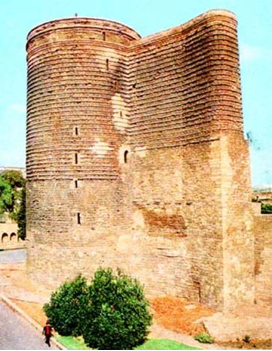
“Maiden’s tower” in Baku (Source: Farroukh Jorat).
Towering fire temple of Sassanian times existed in Ardasher-Khwarrah in the province of Pars (now Firouzabad). This fire temple was built by shah Ardeshir I and was located at the center of the city and it was a 30 m high and spiral in design. This architectural type influenced on architecture of Great Mosque of Samarra in Iraq.
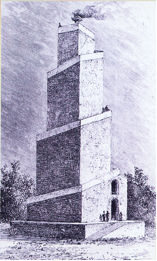
Draft of towering fire temple in Ardasher-Khwarrah (now Firouzabad), Iran (Source: Farroukh Jorat).
In 1964, in front of the “Maiden’s tower” archaeologists found altar of fire, which, unfortunately, was soon destroyed. Altar had three-tier octagonal base, each step was 22-25 cm tall at the center of the upper base has been installed an octagonal tower height of 110 cm and 45 cm at the top of the column is clearly seen traces of fire and oil. The column had no openings for gas, oil burned in the bowl, which is not fully preserved. Place reliance shallow bowl was round a spherical cavity on the top of the column. The whole height of the altar was approximately 225-235 cm.
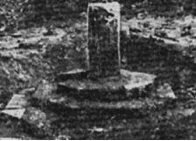
Altar of fire near the “Maiden’s tower” in Baku (Source: Farroukh Jorat).
Sketch of the reconstructed ancient altar of the fire is shown. The altar of this type has been widely distributed by the Medes and Sassanian Iran, where the altars were low (below human growth). Their images carved on coins.
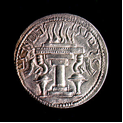
Altar of fire. Coin of shah Ardashir I (Source: Farroukh Jorat).
Arabian invasion. VII-XII AD
In 642, in the Caucasus invaded by an army of the Arab Caliphate, began a violent Islamization. However, despite this, the majority of the population remained Zoroastrians a few centuries after the Arab conquest. Estakhri (X century) mentioned that not far from Baku (i.e., on the Apsheron Peninsula) lived fire worshippers [6]. This was confirmed by Movses Kaghankatvatsi in his reference of the province of Bhagavan (“Fields of the Gods” i.e., “Fire Gods”) [7] and by Aboulfeda [8].
At the same time group of Zoroastrians from Sanjan (now in Turkmenistan) migrated to India. It was the beginning the history of Parsi community.
It is known that when referring to Zoroastrians, Muslims used the word “Gabri”. To the west of Baku is located a desert area, which until the 1940’s was called “Gabristan”. In the 1940’s,after the discovery of rock paintings, this place has become famous, and the name “Gabristan” was deemed invalid because of its consonance with the word “gabir” (“grave” in Azeri) and the district was renamed the “Gobustan”. However, as noted archaeologist Gardashkhan Aslanov, in fact stated, the name Gabristan has no relation to the word “grave” and actually means “Country of Gabris”. It is likely that this desert area was a place for Zoroastrians who were trying not to attract the attention of Muslim rulers. Now the new name “Gobustan” stuck and few people know the old name of the area.
Middle ages. XV-XVII AD
From XV-XVI centuries diplomatic and trade relations between India and Shirvan were expanded. Surakhani Ateshgah was used as sanctuary of Hindus, Sikhs and Zoroastrians.
In 1683 German traveler Engelbert Kämpfer visited Surakhani and mentioned about “seven holes with eternal fires” [9]. “Surakhani” in Persian of Caucasus (language of Surakhani) means “hole with the fountain”. In other words, “Yotnporakyan Bagink” and “Surakhani” is practically calques.
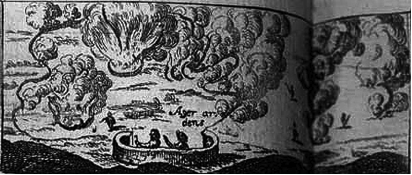
Seven fire holes, picture by Kaempfer, 1683 (Source: Farroukh Jorat).
Chardin in the 17th century reported about Persian Guebres, which worshiped forever burning fire that was in two days’ journey from Shemakha (on the Apsheron) [10].
Engelbert Kaempfer wrote that among people who worshiped fire, two men are descendants of Persians who migrated to India.
French Jesuit Villotte, who lived in Azerbaijan since 1689, reports that Ateshgah revered by Hindus and Guebres, the descendants of the ancient Persians [11].
German traveler Lerch who visited the temple in 1733, wrote that here there are 12 Guebres or ancient Persian fire worshipers» [12].
Around the fire altar (“Chahar-tag”) were cells for pilgrims and guest room (“balakhani”), located at the entrance to the courtyard. According to travelers in the cells as small fires burned.
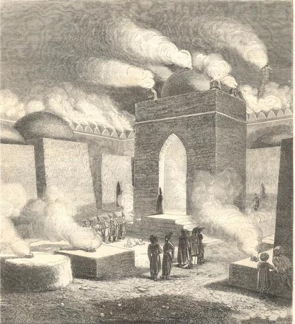
Ateshgah of Baku, XVIII-XIX centuries (Source: Farroukh Jorat).
Despite the fact that the temple was primarily used by a Hindus and Sikhs too, it represents the Sassanian “Chahar-tag” style. Fire temples of this type were in Niasar and other areas of Iran [13].
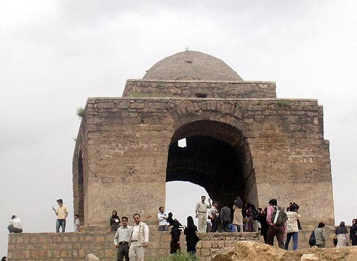
“Chahar-tag” fire temple in Niasar (Iran) (Source: Farroukh Jorat).
On the walls of cells were encrypted dedicatory inscriptions (14 Hindu, 2 Sikh and one Persian inscriptions).
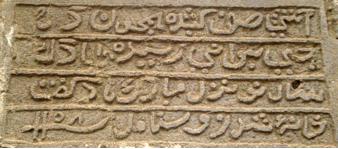
Persian (Zoroastrian) inscription in Ateshgah (Source: Farroukh Jorat).
| آتشی صف کشیده همچون دک جیی بِوانی رسیده تا بادک سال نو نُزل مبارک باد گفت خانۀ شد رو سنامد (؟) سنة ۱۱۵٨ | ātaši saf kešide hamčon dak jeyi bavāni reside tā bādak sāl-e nav-e nozl mobārak bād goft xāne šod ru *sombole sane-ye 1158 |
Fires stand in line
Esfahani Bavani came to Badak
“Blessed the lavish New Year”, he said:
The house was built in the month of Ear in year 1158.
In the first line of inscription author talks about of a number of fires burning in the cells around the temple.
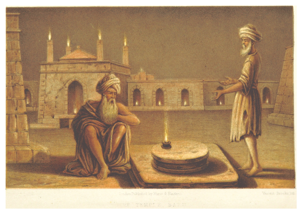 Worshiped fire and small fires stand in line in the background cells (1865) (Source: Farroukh Jorat).
Worshiped fire and small fires stand in line in the background cells (1865) (Source: Farroukh Jorat).
In the second line the author says that he was from Isfahan and Bavan and reached the city of Badak. “Jay” is form of “Gay”, one of the earliest names of Isfahan. Bavan (modern Bavanat) is the village near Esfahan. [14, 15]. The word Badak is a diminutive of Bad-Kubeh. (The name of Baku in the sources of the 17th and 18th centuries was Bad-e Kube).
The 1158 year corresponds to 1745 AD. At the end of the reference is the constellation of Sombole /Virgo (August-September). In the name of the month the master mistakenly shifted the “l” and “h” at the end of the word. According to Zoroastrian calendar Qadimi New Year (Novruz) in 1745 AD was in August.
J. Hanway visited Baku in 1747 and left few records of Ateshgah. People, who worshiped fire in Ateshgah he calls “Indians”, “Persians” and “Guebres”. [16].
S. Gmelin, who visited Ateshgah in 1770, wrote that in the present Ateshgah lived Indians and descendants of the ancient Guebres [17].
XIX AD
As said M. J. Saint-Martin, French orientalist of early XIX century: “The city of Baku is regarded by Parsis as a holy place due to many sources of naphtha with natural burning fire and in many places worshiping a eternal fire”. (La ville de Bakou est regardée par les Parsis comme un lieu saint, à cause du grand nombre de sources de naphte qui s’y enflamment naturellement, et qui, en plusieurs endroits, y entretiennent un feu perpétuel.) [18].
In 1820 the French consul Gamba visits the temple. According to Gamba here lived Hindus and Persian guebres, the followers of Zoroaster. [19].
In 1840 Avraham Firkowicz, a Karaite collector, wrote about his meeting in Darband in 1840 with fireworshiper from Baku. Firkowicz asked him “Why do you worship fire?” Fireworshiper replied that they do not worship fire at all, but the Creator, which is not a person, but rather a “matter” (abstraction) called Q’rţ’, and symbolized by fire. Term Q’rţ’ (“kirdar”) means in Pahlavi and Avestan as “one who does”, “creator” [20].
The Englishman Ussher visited Ateshgah in September 19, 1863. He calls it “Atesh Jah” and said that there are pilgrims from India and Persia [21].
German Baron Max Thielmann visited the temple in October 1872 and in his memoirs he wrote that Parsi community of Bombay sent here a priest who after a few years will be replaced. His presence is necessary, because here come the pilgrims from the outskirts of Persia (Yazd, Kerman) and from India and remain in this sacred place for several months or years. [22].
In 1876 English traveler James Bruce visited Ateshgah. He noted that the Bombay Parsi Punchayat provides a permanent presence in the temple of their priest [23].
E. Orsolle, who visited the temple after Bruce, said that after Parsi priest died in 1864, the Parsi Punchayat of Bombay a few years later sent another priest here, but the pilgrims who came here from India and Iran have already forgotten the sanctuary, and in 1880 there was nobody [24].
O’Donovan visited the temple in 1879 and refers about religious worship of Guebres. [25].
In 1898 in the “Men and Women of India” magazine was published an article entitled “The ancient Zoroastrian temple in Baku”. Author calls Ateshgah as “Parsi temple” and notes that the last Zoroastrian priest was sent there for about 30 years ago (that is, in the 1860s.) [26].
XX AD
Henry in 1905, in his book also noted that 25 years ago (i.e. about in 1880) in Surakhani died last Parsi priest. [27].
In 1855, with the development of oil and gas fields the natural flames of Ateshgah began to fade. In 1887, Ateshgah had greatly weakened flames and was visited by the Emperor Alexander III. The temple flames finally extinguished January 6, 1902.
In 1925 the Azerbaijan Soviet Socialist Republic at the invitation of the “Community for the survey and study of Azerbaijan” visited the famous Bombay Zoroastrian scholar and professor J. J. Modi. Modi claimed that the ancient texts say about the Parsi fire temples on the shores of the Khazar (Caspian) Sea.
Parsi scientist visited completely abandoned Ateshgah, but due to the large number of attributes of the Hindu religion (the inscriptions, trishul) he ranked Ateshgah to Hindu temples. In the Persian inscriptions he was able to partially disassemble only the first and last row.
He visited the “Maiden’s tower”, which he considered as “ancient Ateshkade” (fire temple), and suggested the architectural similarity of the tower, discovered during excavations of the ancient city of Taxila, near Rawalpindi (now Pakistan). It should be noted that Modi’s assumption had remained unconfirmed [28].
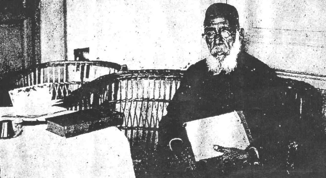
J. J. Modi, Baku, November, 1925 (Source: Farroukh Jorat).
He gave lectures in Baku on the two subjects: “The Parsees” and “The Importance of Azerbaijan from a Parsee Point of View”. His objective was to create an interest in our religion among the local learned people.
After J. J. Modi’s visit Ateshgah 50 years was in oblivion. But since 1975, after the restoration it was re-opened to the public. Flames of Ateshgahs burn again.
XXI AD
Since the 1991 Zoroastrian community of Iran began missionary work outside of Iran. One of the objectives of Zoroastrians of Azerbaijan is the recognition of Zoroastrianism by society and the State as one of the traditional religions of Azerbaijan. Zoroastrians of Azerbaijan, as well as from Iran and India carried out in Ateshgah religious ceremonies.
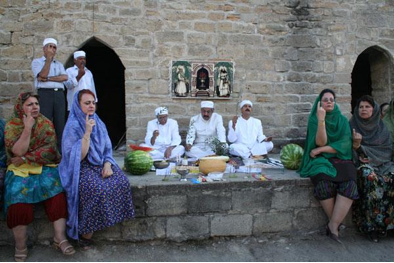
Iranian Zoroastrians in Ateshgah (Source: Farroukh Jorat).
In July 2009, Ilham Aliyev, the President of Azerbaijan announced a grant of AZN 1 million for the upkeep of the shrine.
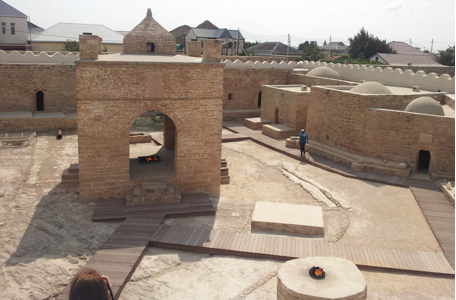
Ateshgah at present days (Source: Farroukh Jorat).
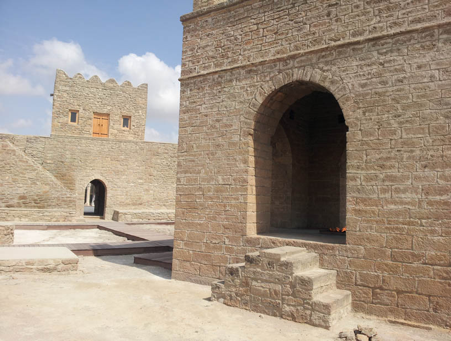
Ateshgah and balakhani (house above the entrance) at present days (Source: Farroukh Jorat).
Footnotes
[1] Herodotus, The Histories, Book III (Thaleia) 92, 94. [2] Kroll Stephan. “Medes and Persians in Transcaucasia: archaeological horizons in north-western Iran and Transcaucasia”, in : G. B. Lanfranchi, M. Roaf, R. Rollinger, eds., Continuity of Empire (?) Assyria, Media, Persia. Padova, S.a.r.g.o.n. Editrice e Libreria, 2003, pp. 281-287. History of the Ancient Near East / Monographs – V. [3] Royal inscription found on the Kabah of Zartusht. An account of how Zoroastrianism was propagated beyond Iranian territories during the Third Century, and other religions suppressed. [4] Movses of Chorene “The History of Armenia”. [5] Alishan. Hin Havatk gam Hetanosagan gronk Hayots (“Ancient Beliefs, or Pagan Religions of Armenia”], pp. 55-56, Venice, 1895). [6] Abu Ishaq Ibrahim ibn Muhammad al-Farisi al Istakhri. Ketāb al-masālek wa’l-mamālek. [7] History of the Caucasian Albanians by Movses Dasxuranci. Translated by C. J. F. Dowsett. London, 1961. [8] Geographie d’Aboulfeda traduite de Parabe en francais et accompagnee de notes et d’eclaircissements par M. Reinaud, t. I-II, Paris, 1848-1883. [9] E. Kämpfer. Amoenitatum exoticarum politico-physico-medicarum fasciculi V, quibus continentur variae relationes, observationes et descriptiones rerum Persicarum et ulterioris Asiae, multa attentione, in peregrinationibus per universum Orientum, collecta, ab auctore Engelberto Kaempfero. Lemgoviæ : Typis & Impensis Henrici Wilhelmi Meyeri, Aulæ Lippiacæ Typographi , 1712, p. 253—262. [10] Chardin J. Voyages en Perse et autres lieux de 1’Orient. Vol. II. Amsterdam, 1735. p. 311. [11] J. Villotte, Voyage d’un missionnaire de la Compagnie de Jésus en Turquie, en Perse, en Arménie, en Arabie et en Barbarie, Paris, 1730. [12] Лерх Иоанн. Выписка из путешествия Иоанна Лерха, продолжавшегося от 1733 до 1735 г. из Москвы до Астрахани, а оттуда по странам, лежащим на западном берегу Каспийского моря. «Новые ежемесячные сочинения», ч. XLIV, февраль, СПб., 1790 г., с. 75. [13] Fire Temple at Niasar. [14] Bavan on Google maps. [15] Ali Akbar Dehkhoda. Loghatnameh, (in Persian), Tehran. [16] Jonas Hanway. An Historical Account of the British Trade Over the Caspian Sea, 1753. [17] Samuel Gottlieb Gmelin. Reise durch Russlaud zur Untersuchung d. drei Naturreiche, p. 45. [18] Saint-Martin M. J. Mémoires historiques et géographiques sur l’Arménie I, Paris, 1818, p. 153-154. [19] Jean Françoise Gamba. Voyage dans la Russie meridionale. II. Paris. 1826. P. 299. [20] Dan Shapira. A Karaite from Wolhynia meets a Zoroastrian from Baku. Iran and the Caucasus, vol. 5, no. 1, 2001, pp. 105-106. [21] Ussher. A Journey from London to Persepolis. pp. 208-207, London, 1865. [22] Thielmann, Journey in the Caucasus, Persia, and Turkey in Asia, Eng. tr. by Heneage, 2. 9-12, London, 1876. [23] James Bryce. Transcaucasia and Ararat: Being Notes of a Vacation Tour in the Autumn Of 1876. [24] E. Orsolle. Le Caucase et la Perse. Ouvrage accompagné d’une carte et d’un plan. Paris, E. Plon, Nourrit et cie, 1885, pp. 130-142. [25] O’Donovan E. Merv Oasis: Travels and Adventures East of the Caspian during the years 1879-80-81. 2 vols. New York, 1883. [26] Men and Women of India. Vol. 1, no. 12, p. 696, Bombay, Dec. 1898. [27] J. D. Henry, Baku, an Eventful History, 1906. [28] Maari Mumbai Bahaarni Sehel – Europe ane Iran-nee Musaafari-naa 101 Patro. 1926, p. 266-279 (English translation: “My Journey outside Mumbai – 101 letters of my Europe and Iran Journeys.” by Ervad Shams-Ul-Ulama Dr. Sir Jivanji Jamshedji Modi. Translated from Gujarati by Soli P. Dastur in 2004.
